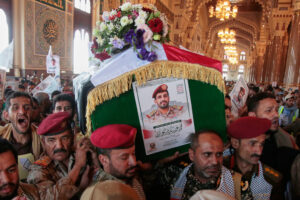Arrested Development: The “New Capital” in Egypt

Cairo, Egypt. Picture by Tarek Siala | Flickr

The most recent economic conference in Sharm El Sheikh, Egypt, was a grand spectacle. Not so much because of the fanfare, well-decorated conference centers or the thousands of Egyptian, American and European politicians. Rather, it was the lofty investments from various Gulf states and the unveiling of a new “capital city”—which will cost about $300 million—that made this conference one of the defining points of President Abdelfattah Al Sisi’s regime so far.
This conference revealed much about the troubling direction in terms of economics and urban development the current regime in Egypt is going towards. While neoliberal practices are intensifying, the working classes are having a harder time finding affordable housing and social services. This economic structure, where real estate, agriculture, and other central industries are partly owned by international companies, alienates the vast majority of Egyptians who are of the working class. Recent statistics from the United Nations World Food Programme show that one out of every two Egyptians is either below or straddling the poverty line.
Neither investors nor government officials have made any efforts to develop sustainable urban infrastructure. If this plan for a new capital follows through, it will remove all of the current government and municipal buildings out of the current downtown urban center; the rest of Cairo will continue to be neglected and its current problems will only get worse.
The new capital city, to be built some 30 miles east of Cairo, was the largest investment made in the conference. The project—devised by the same Emirati business tycoon, Mohammed Alabbar who developed the Burj Khalifa in Dubai—is presented both as a solution to overcrowded Cairo and its immense traffic problems, and as a “smart city,” one that runs on 91 square kilometers of energy farms and will provide about 2 million permanent jobs, and house 5 million residents. “If and when it’s completed,” said BBC correspondent Orla Guerin, the city “will be about the size of Singapore with an airport larger than Heathrow.”
The project planners did not consult with any residents of Cairo. There was also no focus on most urgent urban issues; no mention to the 12 million residents who live in the ‘ashwaiyat or shoddy, informal housing, which make up about 65 percent of the population of Cairo. According to Cities Alliance, the blocks of informal housing continue to grow at a rate of about 5 percent each year, while housing compounds built for the upper middle class are growing at an even faster rate. It is increasingly clear that the priority of investors and the state is to develop exclusive housing for those who can afford it, rather than address the needs of a growing poorer class that are resorting to building informal communities for affordable housing.
In other words, the state intends to build an entirely new, ultra-sleek city from scratch, while ignoring the majority of Cairenes who dwell in very poor living conditions, oftentimes without proper sewage or electricity. There is also no easy access to schools, or the scarce employment opportunities since these ‘ashwaiyat are often on the peripheries of the city.
Cairo highly depends on informal services and networks. People provide services for themselves without depending on the state, which has long remained unresponsive to the needs of the city. Public transportation is partially informal. Most commuters take microbuses, driven by a network of self-employed drivers that cover routes from the downtown city center to the ‘ashwaiyat on the peripheries. For only one Egyptian pound or less per ride, it is the most far-reaching form of public transportation in the city.
But, along with public buses, these modes of transportation contribute to the endemic traffic problem. Although there is also an underground metro system, it only has three lines running across the city, not nearly enough to fulfill the needs of everyday commuters.
If the city wants to reduce traffic and congestion in Downtown Cairo, as they said in the conference, a new Capital is not the solution. There are a number of solutions that could be proposed. Investing in a much more extensive and far-reaching metro system will greatly reduce traffic, for example. This would drive many commuters to use underground transportation in order to ease the volume of crowding aboveground. Instead, the regime and its business partners in the Gulf focus on creating a Potemkin city that mirrors the extravagance of Dubai.
An investment of this size and apparent impulsivity is an indicator of how ingrained and intensified neoliberal practices are within the Egyptian state. There have been dozens of gated satellite cities and compounds that have been built on the peripheries of Cairo over the last ten years, some with the similar extravagance as the capital city.
What Cairo needs in order to truly minimize traffic, congestion, and be a functioning city is formalized public services. Subsidized housing, sanitation, and public transportation will not only be source for new, permanent jobs but will also help get rid of the problems the government has faced for decades with these informal services.
The new capital is a distraction away from more entrenched problems with the urban infrastructure in Cairo. Perhaps the current regime is intentionally eliminating accessibility to the city and its public spaces. “It could be argued there is a sense in which the authorities do indeed wish to diminish the possibility of large scale protests as we have observed on Tahrir,” said Asef Bayat, professor at the University of Illinois at Urbana-Champaign.
Removing the government and municipal buildings away from the downtown area surrounding Tahrir Square takes away the significance of the political protests held in the square. In the current plans for the new capital, there are no public squares and very few public spaces. This shows that the state is attempting to remove public space for political expression altogether.
Such an investment is a route to continued alienation of the poor and working classes. Endemic infrastructure problems in Cairo and its entrenched grassroots solutions are a concern that the regime cannot continue to ignore, let alone hide with a copy of Dubai next door.
Mariam is a masters student in journalism and Middle Eastern studies at NYU. She write on urban space and development, and social movements in the Middle East, with a special focus on modern Egypt. Her work has previously appeared on Mic News, Waging Nonviolence, Muftah Magazine, Your Middle East, and TruthOut.





The point about lack of public spaces is a troublesome one. I’ve heard the same criticism about the overall city design of Dubai. Beyond the political implications there are negative health implications to, with cities designed without public spaces in mind being referred to as ‘obesogenic’ or contributing to obesity. I agree with the reasoning behind the rest of the article, but also would add that I think it should be looked at as an ‘either they fix Cairo or they build a new city’ scenario. The ideal situation would be the construction of a new city that would support the needs of that existing population and allow for decongest ion of current assets to the point that a revivication can take place, funded in part by the gdp growth that would be a possible result of increased incomes and spending patterns. But if it’s as Mariam is saying, and I have no reason to doubt her, then this won’t happen and the poor communities will get left out of development. The thing that developers need to keep in mind is that in order for infrastructure to support the multiples that they profess occur as a result of development, the poor communities need to see economic growth as well. I hope this makes sense, it’s kind of a brainstorm rant. Either way good work Mariam. Such a great and informative article.
Do you have any video of that? I’d love to find out more details.
This site was… how do I say it? Relevant!! Finally I’ve founbd something that helped me.
Cheers!
Having read this I thought it was really enlightening.
I appreciate you taking the time and energy to
put this content together. I once again find myself
spending way too much time both reading and posting comments.
But so what, it was still worthwhile!
Very shortly this web site will be famous among all blogging and
site-building viewers, due too it’sgood posts
homepage
This piece of writing offers clear idea in support of the
new viewers of blogging, that truly how to do running
a blog.
Normally I don’t learn post on blogs, however I wish to say that
this write-up very forced me to check out and do it!
Your writing taste has been surprised me.
Thanks, quite nice post.
My partner and I stumbled over here from a different website and thought I might as well check things out. I like what I see so now i am following you. Look forward to looking into your web page for a second time.|